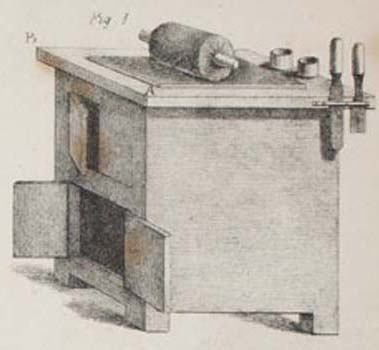“Table for Working Printing Inks.” Detail from plate in Antoine Raucourt, A Manual of Lithography (London:Longman, Rees, Orme, Brown, Green and Longman,1832). Courtesy of the Historical Society of Pennsylvania.
Proper application of printing ink to the stone was crucial to produce a satisfactory lithograph. To accomplish this, lithographic printers used an inking roller of at least four inches in diameter and a marble or lithographic-stone ink slab over twelve inches in length and width. The roller, made from a wood block covered in flannel then calf skin, would be charged with ink that had been applied to the slab by a palette. The printer worked with fresh ink for each new printing and often used leather removable handles on the roller to aid in rolling. His work space, as shown, also usually included ink pots, a handle for palettes, and cubbies to store chemicals and rollers.
Click image for larger view.
